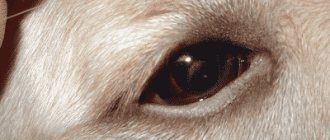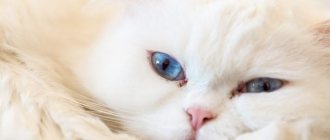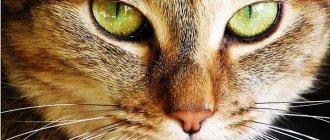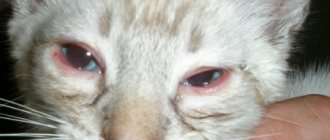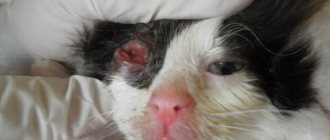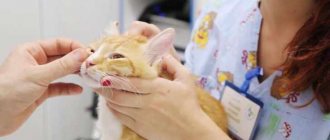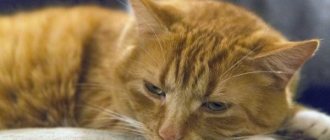Suppuration: normal or pathological?
Eye discharge does not always appear due to pathological processes developing in the body.
In some cases, pus in a cat accumulates under the eyelids for the following reasons:
- weakened immune system;
- improperly selected diet (lack of nutrients);
- infectious, viral damage;
- unsanitary conditions when keeping animals;
- draft;
- eye injuries;
- allergic reaction to household chemicals, perfumes;
- inflammatory processes in the cornea (keratitis);
- dust in the room where the pet is kept.
On a note! If the discharge is abundant and prolonged, you should not resort to self-medication; the animal must be taken for examination to a veterinary clinic, where the doctor will determine the cause and prescribe adequate treatment.
The owner should pay attention to the color of the discharge. Rare discharge of a grayish tint is normal, and thick discharge of a yellowish or green tint most likely indicates the development of pathological processes in the body.
Prevention of eye diseases in cats
Prevention of eye diseases consists of the following actions:
- do not smoke in the room where the pet lives, avoid using perfumes and household chemicals;
- use hypoallergenic ready-made comas of at least premium class;
- destroy ectoparasites and conduct quarterly deworming;
- Vaccinate your pet regularly according to the vaccination plan.
- cats predisposed to eye diseases are periodically instilled with prophylactic agents.
Be sure to read:
What to do if pus comes out of your cat’s nose, what could it be, should you be afraid?
Eye diseases or digestive disorders are caused by human food, so giving your pet a treat can result in illness.
Suppuration: 5 main reasons
The main reasons for the appearance of pus:
- Thick, yellow pus is a sign of an infectious, viral, or fungal disease. The cause of this symptomatology is bacteria or viruses that have entered the animal’s body. Associated symptoms: increased body temperature, apathy, refusal to eat, matted fur around the eyes.
- Cold. If a kitten has a cold, purulent discharge can serve as one of the symptoms of a cold, additional symptoms: sneezing, mucus discharge from the nasal passages, lethargy, chills.
- Ophthalmological diseases. Pathologies of the eyelids, inflammation of the cornea, conjunctiva, blepharitis can become the reason due to which suppuration begins on the organs of vision.
- Allergic reaction. Pus can be released if the animal is allergic to food, household chemicals, perfumes, or pollen.
- In case of mechanical damage to the eye, the wound may become infected, in these cases pus will begin to ooze from the organ of vision.
Be sure to read:
A cat sneezes: causes, symptoms, what to do, treatment methods, what should alert you
Symptoms
The symptoms of purulent discharge, as well as the kitten’s health condition, depend on the cause that caused the appearance of the ichor. Let's look at the main reasons why kittens develop problems and symptoms associated with each specific type of damage:
- Bruised eyelids. If the baby bruises the eyelid, then upon examination you can see a bruise, and adjacent tissues may be crushed. In severe cases, necrosis occurs.
- Wounds of the eyelids, in which the integrity of the kitten’s skin may be compromised, bleeding and pain may occur.
- Blepharitis. The first symptom of blepharitis is redness of the eyelids. If a kitten's eyes are red and festering, this is also one of the signs of illness. In the process of scratching, the pet introduces purulent microflora into the eye: streptococci and staphylococci. Swelling during illness is another symptom.
- Purulent conjunctivitis. Most often, the disease affects both eyes. The kitten looks sick, depressed, and may have a fever. At first, the purulent discharge is liquid, but as the disease progresses, it gradually thickens. The conjunctiva swells and may even protrude beyond the eyes.
- Follicular conjunctivitis. The disease is characterized by damage to the lymph nodes located inside the third eyelid. There is discharge from the conjunctival sac. There is photophobia and pain. The eyelids look swollen. Often the kitten’s eyes do not open and fester, because the ichor sticks together the eyelashes and forms crusts that prevent the opening of the eyelids. The pus irritates the skin around the eyes, which leads to inflammation, dermatitis and eczema develop, and hair loss around the affected area.
What can you do before visiting a doctor?
If there is heavy discharge, do not put off going to the veterinarian. Before going to the veterinary clinic, you can relieve your pet's condition by rinsing the eyes yourself.
Until the causes of the disease are determined and adequate therapy is prescribed, the following should be used:
- weak solution of potassium permanganate,
- herbal infusion,
- decoction of tea leaves.
Any of the above products must be cooled to room temperature.
How to carry out the procedure:
- Calm the animal, secure the paws with a towel, wrap the entire body, and lay it on its side.
- Use a pipette or syringe without a needle to drip warm boiled water onto your eyes to soften dried discharge, and gently wipe your eyelids with a swab.
- Moisten 2 cosmetic discs generously in the solution, wipe each eye with a separate disc.
On a note! To avoid infection in a healthy organ of vision, you should take a new cotton pad after each wiping; repeated use is unacceptable.
During treatment, do not bring the syringe or pipette close to the eyes; the kitten may twitch, which will lead to mechanical injury. Processing is carried out from the outer corner towards the inner.
Suppuration with a runny nose, what to do
Eye discharge accompanied by chills, sneezing, and snot most often indicate a runny nose. For a fragile body, a runny nose can serve as an impetus for the development of serious diseases, such as viral rhinotracheitis or calcivirosis.
If you suspect the development of the disease, you should take the animal to a veterinary clinic, where a doctor will examine it, prescribe tests and a treatment regimen.
Medicines that are most often prescribed for colds to treat suppuration:
- anti-inflammatory drugs,
- antibiotics,
- immunomodulators.
Black discharge from the eyes
The causes of black discharge from the eyes of a cat may be the following:
- Herpes.
- Respiratory infection.
- Chlamydia.
Why are they dangerous? A signal that the pet’s health is not all right. let it not appear outwardly in any way, except for discharge from the eyes.
However, action needs to be taken now. Hurry with the animal to the veterinarian, who will prescribe the necessary tests and treatment.
There is a possibility that the black discharge is a consequence of an eye injury, and not the presence of an infection in the cat’s body. A trip to the veterinarian is mandatory in any case, since the cause needs to be determined exactly.
What drops and ointments to use
For ocular discharge, veterinarians advise using various ointments and drops for treatment. In order for the drug to be beneficial, the owner must follow a number of rules.
How to instill drops:
- Pre-rinse the eye mucosa with herbal decoction or tea leaves.
- Secure the pet and lay it on its side.
- Pipette drops at room temperature.
- Gently drip into outer corners.
- Remove residues with a dry cotton pad.
Be sure to read:
A kitten has watery eyes: what to do, reasons, norm and pathology, characteristics of different breeds
How to apply the ointment:
- Warm the prescribed drug in your palms to room temperature.
- Secure the pet with a towel and lay it on its side.
- With clean hands, place the ointment under the lower eyelids, pulling them slightly.
- Massage the eyelids with the ointment for a few seconds.
- Rub the treated eyes with a dry cotton swab to remove excess.
Commonly prescribed ointments:
- tetracycline eye ointment,
- hydrocortisone,
- solcoseryl.
Popular drops:
- albucid,
- gentamicin drops,
- veterinary drops “Iris”, “Bars”, “Diamond Eyes”,
- levomecithin drops.
How to treat at home
At home, you can try to get rid of pus by regularly treating the mucous membranes of the eyes with a solution of furatsilin, a decoction of medicinal herbs.
It is not advisable to use eye drops purchased at a pharmacy without a prescription from a veterinarian. A dosage suitable for humans can lead to serious consequences if used on a kitten.
You can put tetracycline eye ointment under the patient's lower eyelids.
If the kitten’s condition does not improve 2-3 days after the start of treatment, a visit to the veterinary clinic should be made.
Discharge from the eyes in cats: causes
There are infectious and non-infectious causes of eye diseases.
Among the non-contagious ones, the following are distinguished:
- mechanical injuries;
- allergy;
- hair getting into the eyes of long-haired cats;
- inversions of the eyelids of Rexes and Sphinxes;
- chronic diseases of the kidneys, liver, digestive organs, diabetes;
- tumors.
Among contagious diseases, we most often have to deal with the following infections or infestations:
- Panleukopenia;
- Calcivirosis;
- Rhinotracheitis caused by herpes viruses;
- Cat flu is a combination of calicivirus and herpes;
- Chlamydia;
- Toxoplasmosis;
- Helminthiases.
Be sure to read:
What to do if your cat is sneezing, eyes are watery or festering, reasons
If your pet's eyes are running and no additional symptoms are found, you can try to solve the problem yourself. The most common and affordable way to eliminate the problem is to apply tetracycline eye ointment under the eyelid, which can be purchased at a medical pharmacy.
Washing with folk remedies is acceptable, but ineffective. Therefore, cat owners should have ophthalmic drops in their first aid kit.
Ofthalmosan was developed based on centuries of experience in the use of medicinal herbs. To enhance the therapeutic effect, we added the antiseptic Chlorhexidine and an energy metabolism accelerator - succinic acid, which is formed in the body.
Instead of medicinal herbs, the drug Diamond Eyes used taurine, an amino acid that increases visual acuity. The drops are applied to the conjunctiva and dried with a gauze pad that does not contain lint.
Medicinal solutions can be used for regular preventive instillation into the eyes or nose. If there is no improvement the next day, or if additional pathological symptoms appear, the pet should be taken to the clinic. You need to be careful when treating cat eyes. Microorganisms that cause inflammation of cat's eyes are unsafe for human vision.
Folk remedies
At home, for rinsing, it is recommended to use infusions, solutions, and decoctions prepared on the basis of medicinal herbs.
- Rinse with saline solution.
Add half a teaspoon of table salt to 500 ml of chilled boiled water and stir thoroughly. Rinse eyes 2-3 times a day with cotton pads. Do not use if the condition is caused by an allergen entering the body.
- Treatment with herbal infusion.
Prepare a mixture of dried herbs (calendula, sage) at a ratio of one to one. Pour a couple of tablespoons of the mixture into 500 ml of cold water, place in a steam bath, cook for 12-15 minutes, strain, cool. Carry out treatment several times a day.
- Washing with tea.
Pour a glass of boiling water over a bag of green tea and let it brew. Rinse the organs of vision in case of mechanical injuries, inflammatory processes to relieve inflammation.
- Treatment with solutions of furatsilin, boric acid.
Be sure to read:
The kitten sleeps constantly: physiological and pathological reasons, what affects when to sound the alarm
Prepare a solution at the rate of: 2 drops of furatsilin per tablespoon of boiled water or a pinch of boric acid per glass of boiled water. Treat 2 times a day.
What to do if a kitten’s eyes fester: first aid and treatment
The first thing you need to do is wash the kitten's eyes. At home, this can be done with a gauze swab moistened with chamomile decoction or brewing loose-leaf black tea. If there is no effect from washing, you should show your pet to a veterinarian.
How to wash a kitten's eyes if they fester
The choice of rinsing agent depends on the cause of the suppuration. How to treat a kitten whose eyes are festering cannot be said without a veterinarian’s opinion. Only a doctor has the right to prescribe certain medications and calculate the dosage. What the vet usually recommends:
- If the eyelids are bruised or wounded, the damaged part is cleaned with a solution of hydrogen peroxide. Sometimes rinsing alone is not enough - injections or tablets may be prescribed.
- If the discharge is caused by a cold, then the kitten is provided with a dry and warm sleeping place, without drafts and hypothermia, vitamins are added to the diet and eye drops are prescribed from a veterinary pharmacy (Leopard, Iris, etc.).
- If the crusts interfere with the opening of the eyes, they are softened and removed with petroleum jelly.
- Before instillation, the eyes are washed with a weak solution of furatsilin, and hydrogen peroxide is used to treat the skin around the eyes. For severe infections, antibiotics are prescribed. Most drugs are used topically as eye drops.
If the kitten has contracted the virus, then therapy will focus on expelling it from the body. After recovery, the eyes will return to normal on their own - the purulent discharge will stop. A sick baby will have to be injected with antiviral drugs, antibiotics, vitamin complexes, and in case of exhaustion, nutritional droppers will be needed.
Drops and ointments
If discharge from the eyes is caused by a malfunction of the internal organs or viruses, the drops will be an auxiliary treatment that relieves unpleasant symptoms. Eye diseases are mainly treated with drops and ointments.
For localized purulent discharge from the eyes, the following ointments are used: tetraclycine, erythromycin, chloramphenicol, sofradex, misofen and others. They last longer than drops due to their dense consistency, and are usually used 2 times a day for no more than two weeks.
Drops from a veterinary pharmacy are Iris, Bars, Dekta, Tsiprovet, Barrier, etc. They wash out faster, but are easier to use than ointment. Drops are prescribed as a primary or additional remedy that relieves itching and inflammation and washes the pet's eye.
For more serious conditions, such as purulent conjunctivitis, your veterinarian may prescribe antibiotics. The treatment regimen will directly depend on the type of inflammation.
The main thing: do not self-medicate! This can only make things worse.
How to properly rinse and apply eye drops
Remember that before applying the medications you need to clear the eye of pus and discharge. To do this, just take a cotton pad, moisten it in a solution of furatsilin or saline and move it from the outer corner (from the ear) to the inner one. There should be a separate cotton pad for each eye.
To put drops in a kitten’s eyes without harming or scaring him, you need to wrap him in soft cloth, lay him with his muzzle up and raise his head so that his eyes look straight. After this, the lower eyelid of the diseased eye is slightly pulled back and the drug is applied to the mucous membrane.
If the drug is in the form of a thick ointment, you can cover the eye and lightly massage it through the eyelid so that the medicine spreads better over the cornea.
Even a small kitten can resist an unpleasant procedure. Therefore, if you have a very restless or fearful baby, invite an assistant: he will hold the kitten’s head while you drip the medicine. This will save you from nerves, and the kitten from stress and accidental injuries.
Medications
- Hydrocortisone drops with novocaine - to relieve swelling, inflammation, pain.
- Gentamicin drops - for severe inflammatory processes.
- Albucid drops - for the treatment of injuries.
- Drops with chloramphenicol - for infectious lesions.
- Drops with atropine - for the development of photophobia.
- Solcoseryl ointment - for healing mucous membranes in case of injuries.
- Tetracycline ointment for allergic reactions, to relieve inflammation.

